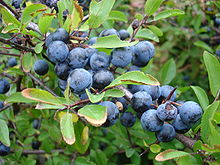

An astringent (sometimes called adstringent) is a chemical that shrinks or constricts body tissues. The word derives from the Latin adstringere, which means "to bind fast". Astringency, the dry, puckering or numbing mouthfeel caused by the tannins[1][2] in unripe fruits, lets the fruit mature by deterring eating. Tannins, being a kind of polyphenol, bind salivary proteins and make them precipitate and aggregate,[3][4][5] producing a rough, "sandpapery", or dry sensation in the mouth.
Squirrels, wild boars, and insects can eat astringent food as their mouths are developed to be resistant to its effects.[6]
In Ayurveda, astringent is the sixth taste (after sweet, sour, salty, pungent, bitter) represented by "air and earth".[7][8]
Smoking tobacco is also reported to have an astringent effect.[9]
In a scientific study, astringency was still detectable by subjects who had local anesthesia applied to their taste nerves, but not when both these and the trigeminal nerves were disabled.[10]
Uses[edit]
In medicine, astringents cause constriction or contraction of mucous membranes and exposed tissues and are often used internally to reduce discharge of blood serum and mucous secretions.[11] This can happen with a sore throat, hemorrhages, diarrhea, and peptic ulcers. Externally applied astringents, which cause mild coagulation of skin proteins, dry, harden, and protect the skin.[12] People with acne are often advised to use astringents if they have oily skin.[13] Mild astringents relieve such minor skin irritations as those resulting from superficial cuts; allergies; insect bites;[12] anal hemorrhoids;[14] and fungal infections such as athlete's foot.[15] Redness-reducing eye drops contain an astringent. Use of Goulard's Extract has been discontinued due to lead poisoning.[citation needed]
Examples[edit]
Some common astringents are alum, acacia, sage,[16] yarrow,[17] witch hazel, bayberry, distilled vinegar, very cold water, and rubbing alcohol. Astringent preparations include silver nitrate, potassium permanganate, zinc oxide, zinc sulfate, Burow's solution, tincture of benzoin, and such vegetable substances as tannic and gallic acids. Balaustines are the red rose-like flowers of the pomegranate, which are very bitter to the taste. In medicine, their dried form has been used as an astringent.[18] Some metal salts and acids have also been used as astringents.[19]
Calamine lotion, witch hazel, and yerba mansa, are astringents,[20] as are the powdered leaves of the myrtle.[21] Ripe fruits and fruit parts including blackthorn (sloe berries), Aronia chokeberry, chokecherry, bird cherry, rhubarb, quince, jabuticaba and persimmon fruits (especially when unripe), banana skins (or unripe bananas), cashew fruits and acorns are astringent.[22] Citrus fruits, like lemons, are somewhat astringent. The tannins in some teas, coffee, and red grape wines like Cabernet Sauvignon and Merlot produce mild astringency.[citation needed] Astringency is used in classifications of white wine.
References[edit]
- ^ Ray, P. K. (2002). Breeding Tropical and Subtropical Fruits. Springer Science & Business Media. ISBN 9783540428558. Retrieved 2018-12-08.
- ^ Joslyn, Maynard (2012-12-02). Methods in Food Analysis: Applied to Plant Products. Elsevier. ISBN 9780323146814.
- ^ Fennema, Food Chemistry, 4th ed., p. 656.
- ^ Breslin, P.A.S.; Gilmore, M.M.; Beauchamp, G.K.; Green, B.G. (1993). "Psychophysical evidence that oral astringency is a tactile sensation". Chemical Senses. 18 (4): 405–417. doi:10.1093/chemse/18.4.405.
- ^ Bertsch, Pascal; Bergfreund, Jotam; Windhab, Erich J.; Fischer, Peter (August 2021). "Physiological fluid interfaces: Functional microenvironments, drug delivery targets, and first line of defense". Acta Biomaterialia. 130: 32–53. doi:10.1016/j.actbio.2021.05.051. hdl:20.500.11850/498803. PMID 34077806. S2CID 235323337.
- ^ Choi, Nak-Eon; Han, Jung H. (2014-12-03). How Flavor Works: The Science of Taste and Aroma. John Wiley & Sons. ISBN 9781118865453.
- ^ Desai, Urmila (1990). The Ayurvedic Cookbook: A Personalized Guide to Good Nutrition and Health. Lotus Press. ISBN 9780914955061.
- ^ Lad, Vasant (2002). Textbook of Ayurveda. Ayurvedic Press. ISBN 9781883725075.
- ^ McBride, Nome. "Herbal Smoking Mixes" (PDF). Traditional Roots Institute. Retrieved 2022-07-20.
- ^ Jiang, Yue; Gong, Naihua N.; Matsunami, Hiroaki (2014). "Astringency: A More Stringent Definition". Chemical Senses. 39 (6): 467–469. doi:10.1093/chemse/bju021. ISSN 0379-864X. PMC 4064959. PMID 24860069.
- ^ Brodin, Michael (1998). The Over-The-Counter Drug Book. Simon and Schuster. p. 382. ISBN 978-0-671-01380-6. Retrieved 4 June 2014.
- ^ a b Peter A. Ciullo (31 December 1996). Industrial Minerals and Their Uses: A Handbook and Formulary. William Andrew. p. 407. ISBN 978-0-8155-1808-2. Retrieved 4 June 2014.
- ^ Acne from http://www.brown.edu
- ^ Acheson, Austin; Scholefield, John (2008-02-16). "Management of haemorrhoids". BMJ. 336 (7640): 380–383. doi:10.1136/bmj.39465.674745.80. PMC 2244760. PMID 18276714.
- ^ Dockery, Gary L.; Crawford, Mary Elizabeth (1999). Color Atlas of Foot and Ankle Dermatology. Lippincott Williams & Wilkins. p. 171. ISBN 978-0-397-51519-6. Retrieved 4 June 2014.
- ^ Dorland, W. A. Newman (1907). The American illustrated medical dictionary (4th ed.). Philadelphia and London: W.B. Saunders company. pp. 14, 39, 635. Retrieved 4 June 2014.
- ^ Grieve, Maud (1 June 1971). A Modern Herbal: The Medicinal, Culinary, Cosmetic and Economic Properties, Cultivation and Folk-lore of Herbs, Grasses, Fungi, Shrubs, & Trees with All Their Modern Scientific Uses. Dover Publications. pp. 863–864. ISBN 978-0-486-22799-3. Retrieved 4 June 2014.
- ^ History of Science: Cyclopædia, or, An universal dictionary of arts and sciences…
- ^ Gregory, James (1833). Conspectus medicinae theoretic medicine; in two parts: Part I. Containing physiology and pathology. Part II. Containing therapeutics (2nd ed.). London: Stirling & Kenneg. pp. 255–256. Retrieved 4 June 2014.
- ^ Anemopsis californica from University of California, Irvine
- ^ Borg, John (1927). "Descriptive flora of the Maltese Islands".
{{cite journal}}: Cite journal requires|journal=(help) - ^ Choi, Nak-Eon; Han, Jung H. (2014-12-03). How Flavor Works: The Science of Taste and Aroma. John Wiley & Sons. ISBN 9781118865453.
External links[edit]
 The dictionary definition of astringent at Wiktionary
The dictionary definition of astringent at Wiktionary